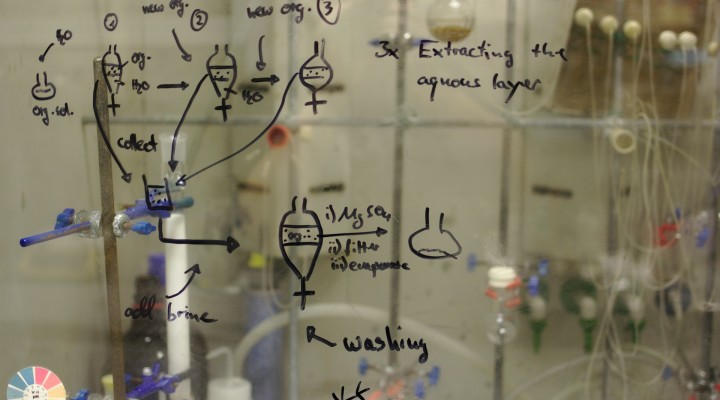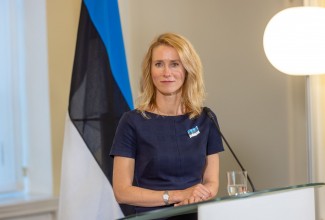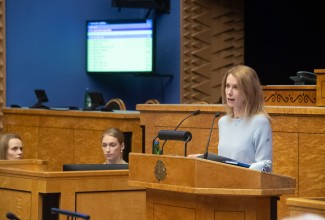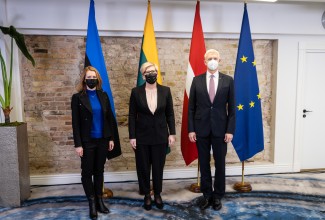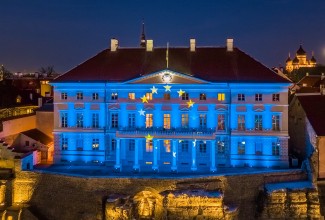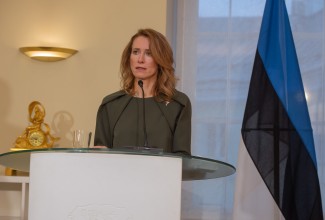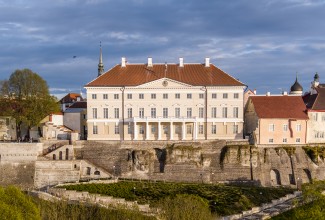Without research and development we will not meet a single one of our development needs, be it related to the environment, health, enterprise or state governance. In the development of our society we have reached a stage where the importance of solutions created with the support of research and development is growing in all fields and all sectors. The problems we are faced with today in society and in the world generally have become much more complex and multifaceted than they were 10 or 20 years ago. This is only to be expected, but it means much greater responsibility when making decisions that affect the state and society.
Esteemed Riigikogu,
Funding for research and development is guaranteed by our coalition agreement and is growing. Competition-based and baseline funding for research are in balance again for the first time in many years. We have increased both by six million euros this year. In place of investments, universities and companies have increased their spending on the salaries of scientists, because new knowledge can only be generated by people, not buildings or complex apparatus alone. In 2020, labour costs in the field of research and development rose by 14%.
The government has kept to its broadly agreed aim in regard to the funding of research. Last year, 1% of GDP was allocated from the state budget in support of research and development. Likewise this year. Despite the extraordinary times and the energy, security, health and climate crises we face, we have raised the state budget resources being channelled into research and development.
Marked changes have been occurring in private-sector research and development. In 2019, private-sector spending on research and development outstripped that of the public sector. This is a long-awaited development. In 2020, such spending increased further, exceeding 1% of GDP for the first time in a decade: a total of 481 million euros was spent on research and development in the public and private sectors, which was 115 million more than just two years previously. These changes will soon bear fruit.
In terms of spending on research and development proportional to GDP, we were ranked 11th in the European Union for the second year running. A lot of hard work lies ahead of us if we are to catch up to the Nordic countries, although with us spending 1.8% of GDP on research and development, we are better placed than Latvia at 0.7%, Lithuania at 1.2% and Poland at 1.4%. In absolute terms, private-sector expenditure on research and development in Estonia was more than four times higher than the amount spent in Latvia, while companies in Lithuania – which is significantly larger than us – spent the same amount that we did.
Estonian employers have taken their signatures on the Research Agreement very seriously. The 2% Club was launched from a desire to highlight the importance of investments in research and development via success stories. The companies who make up this club are already investing at least 2% of their turnover, or a million euros a year, in research and development. In order to promote further innovation in other companies, the Innovation Start-Up Chamber has been established as part of the Estonian Employers’ Confederation. The number of scientists and engineers in the entrepreneurship sector is growing, and they are becoming younger all the time. I am sure this trend will support the continued development of Estonia’s industrial companies and the achievement of the productivity goal we have set for 2035.
Alongside very effective basic research, the volume of applied research and testing and development work is rapidly growing. This means that we are able to put the knowledge created to ever better use for the benefit of people’s welfare and the economy.
An increasing proportion of state budget spending on research and development reaches scientists via ministries, helping the state make smarter choices in addressing the development needs of society. In 2020, the volume of applied research in the state sector grew by 50% and in universities by almost 25%. Never before has the state commissioned so much research for the resolution of issues within areas of governance.
Another example is the research that has been carried out in regard to the pandemic and the impact it has had on society: Professor Krista Fischer’s models, Professor Ruth Kalda’s monitoring data and Professor Tanel Tenson’s waste water samples. On the basis of these analyses, the government has made decisions directly affecting the population in fighting the spread of coronavirus. This cooperation has been a learning curve, in the best sense of the term, and constructive for politicians, scientists, officials and the public alike.
A new applied research programme has been successfully launched to support companies in initiating, funding and finding suitable partners for such research. During its first year alone, more than 200 local companies consulted Enterprise Estonia on development plans, and almost 100 technology projects have undergone assessment. As a result of two rounds of application, research and development projects to the value of 43 million euros have been launched which will transform the technologies, processes and products used by companies to date. There has been such a high level of interest in applied research among entrepreneurs that we have already increased the volume of the programme. We have earmarked 20 million euros for these developments in 2022 as well.
An example is the next-generation parcel-delivery robots being developed by Cleveron with the support of the programme, with which goods ordered online will be able to be conveniently delivered to consumers. In cooperation with researchers from TalTech, the company R-S OSA is working on technology that will enable the use of oil shale ash as a raw material, while the focus of development in Eesti Energia and Viru Keemia Grupp is the repurposing of plastic waste which we are currently unable to recycle. The contribution of scientists to making the economy and society knowledge-based has never been greater.
Universities too have set up units and launched a range of activities in support of the knowledge and technology transition. Last year, Antegenes – the personal medicine spin-off company which formed around researchers from the University of Tartu – secured a major investment from and a strategic partnership with a foreign company. Thanks to this, innovative gene tests developed by Estonian scientists for the prevention of cancer will reach the British market.
The energy crisis brings to mind the research-based cooperation of scientists from TalTech with KredEx and construction companies to develop and pilot the factory-based insulation of apartment buildings. This will not only help us achieve our climate goals, but also relieve financial pressure on families by reducing energy costs. The energy use of our office buildings is anything but efficient as well. The need for a transfer of knowledge in this field is great, and growing. Thankfully, we are able to give more such examples with every passing year.
Esteemed Riigikogu,
Needless to say, there remains a lot of work for us to do. The development needs of Estonian society represent an opportunity for economic and social innovation. Estonia’s target in implementing the green and digital transitions must be a developmental leap in society and growth in well-being.
American astronaut Jim Lovell once remarked that getting to the moon wasn’t a miracle: “We just decided to go,” he said. In order to succeed in major undertakings, we need a great many people and institutions and companies who will take such decisions.
Skeleton Technologies and TalTech have taken on the challenge of turning Estonia into a research and development hub for high-tech energy-storage systems. This is a perfect example of cooperation between companies, scientists and the state and of a new ecosystem in a technology-intensive field which will be of benefit to Estonian science, to our economy and to our environment, and indeed to the development of green technology in general.
Researchers from the University of Tartu, led by Professor Enn Lust, are working with the company H2Electro to construct an electrolyser based on innovative technology. This is a vital link in the green hydrogen production cycle that will help to store wind and solar energy as hydrogen. In cooperation with the company AuVeTech, researchers from the same institute have produced the first Estonian-made fuel element, which is capable of turning hydrogen into electricity.
We must contribute to the rise of such ecosystems in other fields as well, be they personal medicine, smart food production or artificial intelligence, to name but a few.
The government is also creating new equity instruments to contribute to the development of knowledge-intensive companies in Estonia that support the green transition. Investments in new technology come with risks, but their success will grow our smart exports and help us to achieve our climate goals. Moreover, a substantial proportion of Just Transition Fund and NextGenerationEU recovery plan measures are aimed at supporting innovation and growing the smart economy. Much work lies ahead of us, however, in ensuring that these have the desired impact on Estonia’s economy and regional development.
Science is free, and we are rightfully proud in Estonia of the autonomy our research institutes enjoy. But in addressing the development needs of our country, a contribution from fundamental research is also required. In the long term, most innovation is still born from basic research, but comprehending the value of its results can take time. Unlike with applied research and development support, we will not start nominating areas of research in supporting fundamental research in the future. However, through their own choices, all scientists have the chance to make an important contribution to these changes.
In order to reach the targets we have set, we need more workers with research experience. In terms of the number of researchers per 1000 workers, we fall well behind quite a number of OECD countries. The proportion of doctorates being defended in Estonia is 87% of the European Union average. Luckily we need not compare ourselves in this regard to Latvia, at just 22% of the EU average, or to Lithuania, at 48% of the average: the examples we follow are Finland and Sweden, in both of which doctorates are defended at the rate of 139% of the European average.
The number of doctorates being defended in Estonia’s universities must be increased. I am in agreement with President Alar Karis that the yardstick of education and wisdom is not the number of diplomas or degrees a person has, but their ability to put their knowledge to use. Which is to say that doctoral studies transform people into researchers.
We must significantly boost young Estonians’ interest in doctoral studies and careers as scientists in order to secure the future of Estonian-language higher education and research. It is not a case of us having too many foreigners with doctorates, but too few Estonians with them. Universities can only hire those with doctorates as lecturers. Estonian higher education can only be provided by Estonian-speaking people with doctorates. More and more companies and state authorities require their help.
A potential solution in this regard has been presented to the Riigikogu by the government: a package of doctoral studies reforms. Its aim is to make doctoral studies more attractive and better paid as a career choice and to create a variety of pathways via which such studies can be completed. A total of six million euros has been allocated from the national budget for 2022 for the implementation of these reforms. It is now up to universities and their partners to generate the content of the reforms. The plan is to shift the approach to doctoral studies in such a way that an ever-growing number of graduates start working, and leading life in Estonian forward, outside of universities. In this way we will come closer to achieving our goal of a more knowledge-intensive state and society.
Last year saw the completion of the Estonian Research and Development, Innovation and Entrepreneurship Development Plan for 2021-2035. The expectation of the new strategy is that it will further increase the joint contribution made by the scientific community and entrepreneurs in developing both society and the economy. To this end, we have bolstered the role played by the Research and Development Council in strategic decision-making pertaining to research and development and innovation. The competence in terms of innovation and transfer of knowledge represented by the current members of the council is the strongest it has ever been. Work is beginning on the Entrepreneurship and Innovation Foundation established on the basis of Enterprise Estonian and KredEx.
Shortly to be debated by the Riigikogu is the new Act on the Organisation of Research and Development and Innovation. In order to achieve the objectives set out in the Research and Development, Innovation and Entrepreneurship Development Plan, we must also review the management, organisation and funding of and the roles played by the various parties in the field. As a step towards more consistent policy-shaping, we are regulating for the first time, as part of the same act, the national organisation of both research and development and innovation.
In preparing the new act we have not forgotten our values, our roots or our language. No one will study or involve themselves in these things if we do not do so ourselves. For this reason, in the new act we propose that in the performance-based funding model of science, general quality and performance indicators and indicators on contributions to the development of entrepreneurial cooperation and society should be joined by indicators pertaining to the development of Estonian fields of study. This is important to us because promoting such fields is a prerequisite for the survival of our culture and state.
Estonia is a small country, which in many ways is a good thing. But it inevitably means that we have far fewer people and resources with which to involve ourselves in everything in as much depth or as effectively as others. We have to make choices. At the end of last year we started the ball rolling on work to flesh out the five focus areas of research and development selected in the development plan. These areas are digital solutions, health technology, resource enhancement, sustainable energy solutions and a viable Estonia that focuses on fields connected to the development of Estonian society, nationality and cultural space.
We are continuing to negotiate with research institutes, entrepreneurs, professional associations and ministries to specify the actions that need to be taken for the development of the selected areas and ways in which this can be funded. These areas are very different in nature, which is why their needs are so different. We want to have produced roadmaps for the development of these focus areas by the end of spring so that we can launch the required measures in autumn.
Dear audience,
Estonia’s researchers and leading scientists have been doing outstanding work for many years now. They have been at the global forefront in a number of areas and raised their level even in times of limited funding. Thank you all for managing to do so!
Together with you we are now seeing that Estonia’s robust science is quietly starting to make our economy and society stronger. A great deal of work has been done to achieve this, accompanied by disappointments and setbacks, but also by lessons that have driven things forward. We have to maintain that forward motion and boost it even further.
The state budget funding for research and development is growing by 40 million euros in 2022, to a total of 323.7 million euros. The public sector has never contributed more to research and development than it is doing today. This impetus is much needed by our scientists and companies in order for them to make progress.
Changing the structure of the economy and changing people’s habits are not easy, but we have no choice. If we do not do so, sooner or later social welfare and wage growth will dry up in Estonia and development needs will go unmet.
Developments in recent years give us reason to believe that things will not pan out that way. The leading research being carried out in our country is contributing more and more visibly to the development of our society and economy. An increasing number of entrepreneurs have chosen in favour of knowledge-based and technology-intensive development. The state is in the final phase of creating an environment that favours such change. Our targets have been agreed upon. May we continue to have the wisdom and determination to move towards achieving them!
Thank you all.
